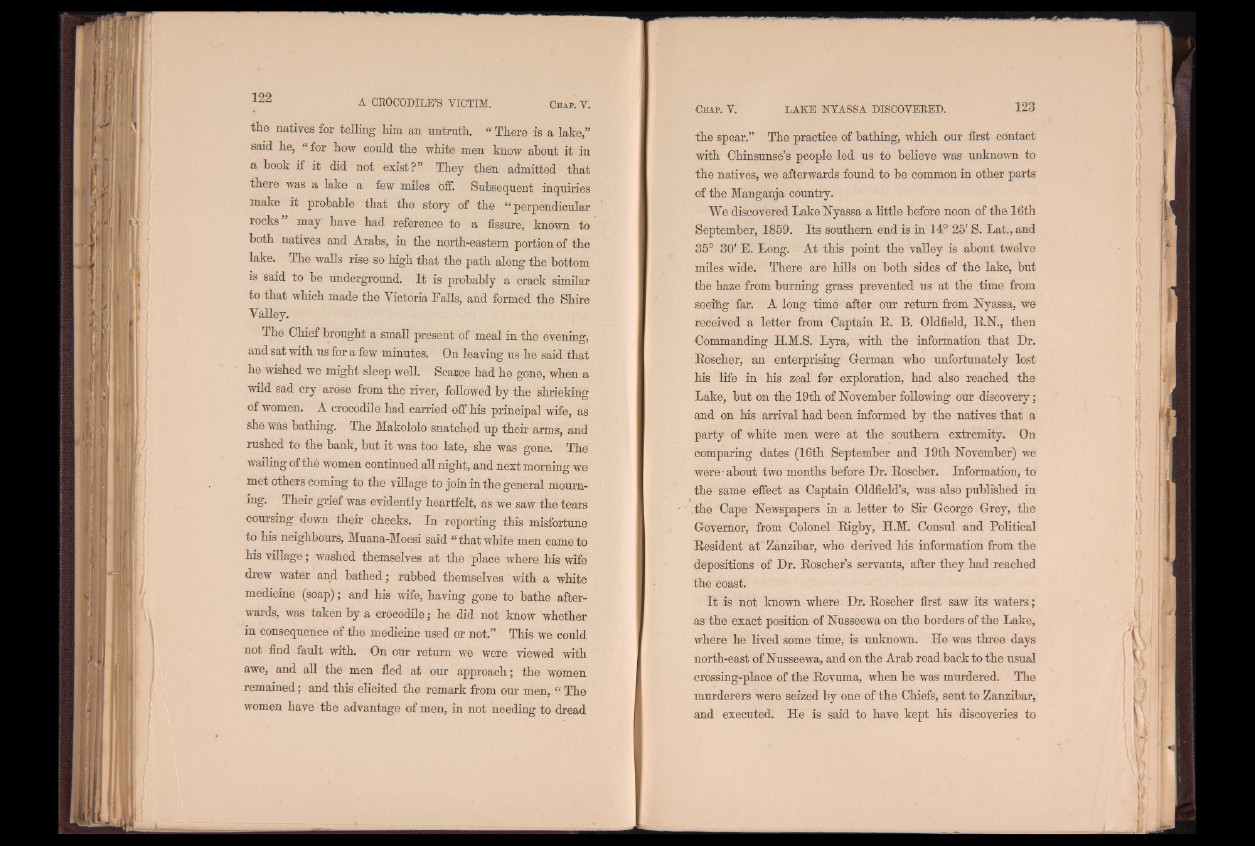
the natives for telling him an untruth. “ There is a lake,”
said he, “ for how could the white men know about it in
a book if it did not exist?” They then admitted that
there was a lake a few miles off. Subsequent inquiries
make it probable that the story of the te perpendicular
rocks may have had reference to a fissure, known to
both natives and Arabs, in the north-eastern portion of the
lake. The walls rise so high that the path along the bottom
is said to be underground. I t is probably a crack similar
to that which made the Victoria Falls, and formed the Shire
Valley.
The Chief brought a small present of meal in the evening,
and sat with us for a few minutes. On leaving us he said that
he wished we might sleep well. Scarce had he gone, when a
wild sad cry arose from the river, followed by the shrieking
of women. A crocodile had carried off his principal wife, as
she was bathing. The Makololo snatched up their arms, and
rushed to the bank, but it was too late, she was gone. The
wailing of thè women continued all night, and next morning we
met others coming to the village to join in the general mourn-
ing. Their grief was evidently heartfelt, as we saw the tears
coursing down their cheeks. In reporting this misfortune
to his neighbours, Muana-Moesi said “that white men came to
his village ; washed themselves at the place where his wife
drew water and bathed ; rubbed themselves with a white
medicine (soap) ; and his wife, having gone to bathe afterwards,
was taken by a crocodile ; he did not know whether
in consequence of the medicine used or not/’ This we could
not find fault with. On our return we were viewed with
awe, and all the men fled at our approach ; the women
remained ; and this elicited the remark from our men, “ The
women have the advantage of men, in not needing to dread
the spear.” The practice of bathing, which our first contact
with Chinsunse’s people led us to believe was unknown to
the natives, we afterwards found to be common in other parts
of the Manganja country.
We discovered Lake Nyassa a little before noon of the 16th
September, 1859. Its southern end is in 14° 25' S. Lat., and
35° 30' E. Long. At this point the valley is about twelve
miles wide. There are hills on both sides of the lake, but
the haze from burning grass prevented us at the time from
seeiftg far. A long time after our return from Nyassa, we
received a letter from Captain E. B. Oldfield, E.N., then
Commanding H.M.S. Lyra, with the information that Dr.
Eoscher, an enterprising German who unfortunately lost
his life in his zeal for exploration, had also reached the
Lake, but on the 19th of November following our discovery;
and on his arrival had been informed by the natives that a
party of white men were at the southern extremity. On
comparing dates (16th September and 19th November) we
were • about two months before Dr. Eoscher. Information, to
the same effect as Captain Oldfield’s, was also published in
.the Cape Newspapers in a letter to Sir George Grey, the
Governor, from Colonel Eigby, H.M. Consul and Political
Eesident at Zanzibar, who derived his information from the
depositions of Dr. Eoscher’s servants, after they had reached
the coast.
I t is not known where Dr. Eoscher first saw its waters;
as the exact position of Nusseewa on the borders of the Lake,
where he lived some time, is unknown. He was three days
north-east of Nusseewa, and on the Arab road back to the usual
•crossing-place of the Eovuma, when he was murdered. The
murderers were seized by one of the Chiefs, sent to Zanzibar,
and executed. He is said to have kept his discoveries to